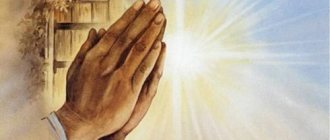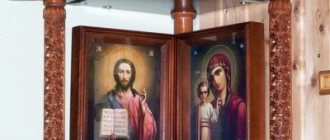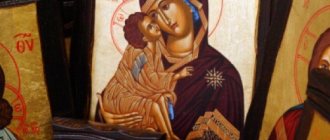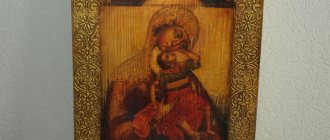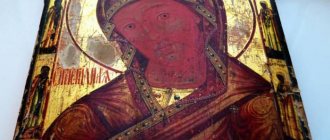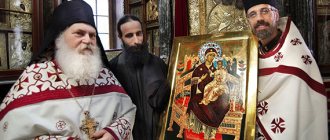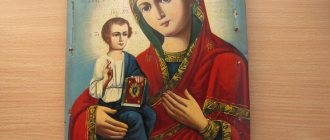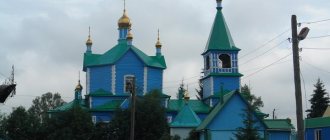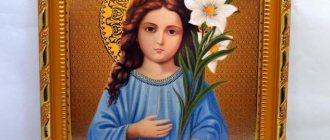Now popular is the spread of so-called ecumenism, that is, the desire to unite all Christian denominations into a single faith. In general, the concept looks quite appropriate and useful, but if you pay attention to some fundamental differences between the branches of Christianity, the difficulty of such a unification becomes clear. Take, for example, Catholic icons in comparison with Orthodox ones; almost every detail here speaks of a fundamental and significant difference between the traditions. Also, these differences allow us to better understand how these schools of Christianity differ.
Do Catholics have icons?
In the strict Orthodox sense, Catholics practically do not use icons as such; they use paintings on religious themes, which can depict saints, Christ and other, let’s say, thematic characters.
This is the main vector, but there is also something in common. For example, there is the Seraphim-Diveyevo Icon of Tenderness, which belongs to the Catholic tradition, but Seraphim of Sarov prayed in front of this icon.
Catholics also venerate many Orthodox icons, mainly the Mother of God. Orthodox Christians can use the image of the Catholic Church icon of the Prayer of the Cup, which depicts Christ in the Garden of Gethsemane.
However, these facts are particulars, but in general there are differences and very significant ones, the main ones being:
- canons - in Catholicism there are practically no such canons; everyone paints an icon based on their own understanding of aesthetics and religious dogma;
- authorship - icons in the Catholic Church are painted by a specific author and a considerable number of famous painters created such works of art, in Orthodoxy even famous authors (such as Rublev, for example) often created works not alone, but in collaboration with students or other icon painters and authorship was never given factor, which was generally spoken of in a special way, everything was subject to the canon;
- goal - Catholics do not often pray in front of the icons themselves, they can only use them to create an atmosphere and an appropriate mood, but as such, veneration of icons in the form of prayer is not common there;
- symbolism - in Orthodoxy there is a powerful school of symbolism, which is established by the canon, each color has a meaning, each symbol reveals additional details of the image, in Catholicism colors and shapes can be used simply for artistic expression;
- details - there are differences in many details, for example, for Catholics the left palm of the depicted saint is located on top (for the Orthodox - the right one); the halo in Catholicism is more reminiscent of a crown and is located above the head, but in Orthodoxy the halo surrounds the head completely and seems to be all-pervading glow.
Now it is not difficult to understand whether there are icons in the Catholic Church - they are almost everywhere there, but they look more like paintings and are created in order to create a special prayer atmosphere.
Therefore, they can simply be located on the walls; there may be no space in front of them for prayer. Also, they are created not by specially trained icon painters who convey the tradition and experience of faith (in Orthodoxy) but by professional artists.
Catholic iconography of the Virgin Mary
Catholic iconography of the Virgin Mary is a set of types of images of the Virgin Mary in Western European art and a system for their study.
List of Catholic icons of Our Lady:
- Annunziata is a depiction of the Madonna in the Annunciation scene, but without the Archangel Gabriel.
- Assunta - image of the Madonna, after death ascending to heaven, Feast of the Assumption of the Virgin Mary (August 15)
- Immaculata is a depiction of the Immaculate Conception of the Virgin Mary, in which the Madonna is depicted floating in the heavens on a crescent moon.
- The Coronation of the Mother of God is the coronation of the Virgin Mary as the Queen of Heaven after her Ascension into heaven.
- Madonna in glory
- Misericordia is an image of the Madonna of Mercy, protecting people with her veil.
- Maesta is a solemn image of the Madonna enthroned surrounded by saints.
- Mary with Pregnancy or Our Lady in Childbirth is an image of a pregnant Mary.
- The mystical betrothal of St. Catherine - the image of the Madonna on the throne with the baby Jesus on her lap and St. Catherine of Alexandria, betrothed to Jesus with a ring.
- The Immaculate Heart is an image of the Madonna with a sparkling heart in her chest, framed by a wreath of roses.
- Pieta - Mary mourning Jesus taken down from the cross.
- Holy Kin is an image of the Virgin Mary with Jesus along with St. Anne and St. John the Baptist.
- The Holy Family is an image of Mary with Joseph and the baby Jesus.
- The Holy Conversation is an image of the Madonna enthroned surrounded by conversing saints.
- Anna selbdritt or Saint Anne, Mary and the Child Jesus is a depiction of the Madonna along with her mother Saint Anne and the Child Jesus.
- Hortus conclusus is an image of the Madonna in the Garden of Eden (in the Orthodox tradition, a similar image is called the Prisoner Vertograd).
- Mater dolorosa is an image of the Suffering Mary with a sword in her heart, looking at the crucified Christ.
- Mulier amicta sole - an image of the Virgin Mary surrounded by the sun, wearing a crown of stars and with the moon under her feet. The image is taken from the 12th chapter of the Revelation of John the Theologian.
"The Annunciation" by Sandro Botticelli
Catholic icons are more sensual, they depict real people, not images of them. In Botticelli's religious painting, Mary appears as an earthly, beautiful girl, in an emotional pose that speaks of her embarrassment before the Archangel Gabriel.
All the details of the picture are clearly defined - shadows, elements of clothing, facial features. There is perspective - all objects become smaller as they move away; this does not exist in Orthodox icons.
There is an emphasized division of space into internal and external, which is not present in Orthodox iconography: the Archangel and the Virgin Mary are indoors, the city landscape is depicted outside the window.
The halos above their heads are brown (in Orthodoxy - a symbol of decay and human nature) and are more like hats, looking like separate objects. On Orthodox icons they are always made in light colors and emanate from the depicted image, representing, as it were, a radiance emanating from within. The colors of the painting have no symbolism.
Icon "Ustyug Annunciation"
The icon “Ustyug Annunciation” was made in a completely different way. The action takes place in another, two-dimensional dimension - there is no depth. This and the light, golden background, symbolizing the Heavenly Kingdom, emphasize the difference between the Mother of God and the Archangel from ordinary people.
From some details one can understand that the action of the icon still takes place in a specific place - a temple, but this space is still different, divine, not of this world.
The figures are vertical, without emotional gestures or impulses. The entire icon seems to be directed upward. The Archangel's hand is raised for blessing, the appearance of the Mother of God speaks of a humble acceptance of God's will. Unlike Botticelli's painting, there is no emphasis on the beauty of clothes or faces. Pure, humble, emotionless faces are a characteristic feature of Orthodox icons.
All colors have meaning: the purple clothing of the Virgin Mary emphasizes her greatness, the green tones present in the clothing of the Archangel Gabriel mean life, the joyful news of the conception of a new life.
Thus, in the Orthodox icon the spiritual predominates; vertical, speaking of aspiration to Heaven. In Botticelli’s painting, on the contrary, the earthly principle is emphasized, the horizontality of the image is expressed, as if tying the action to the earth.
The most famous Catholic icons in Belarus
The most famous Catholic miraculous icon that arrived in Belarus 5 centuries ago is the image of the Mother of God of Budslav in the small village of Budslav near Naroch, which attracts tens of thousands of pilgrims from both the Republic of Belarus and Poland to its National Sanctuary every year on the first Sunday in July , Lithuania, Latvia, Ukraine, Russia..
No less famous is the icon of the Mother of God of Trokelskaya in the village. Trokeli (from the end of the 16th century) near the city of Lida in the Grodno region, which is an excellent copy of the famous Roman icon of Santa Maria Moggiore (“Snowy”)
Also in the historically pro-Catholic Grodno region from the middle. of the Mother of God of the Scapular in the small village of the 17th century is very popular Gudogai (not to be confused with the village and railway station of the same name). Which is a copy of the famous icon of the Mother of God of Vladimir “Tenderness”:
In Grodno itself, in the cathedral, for more than three centuries, the miraculous icon of the Mother of God of the Congregate (or among young people, also “Student” ), which is also a copy of the Italian Santa Maria Mojre, has been venerated:
Another wonderful icon of the West. Belarus is located in the Brest church-sanctuary of the Exaltation of the Holy Cross: the image of the Mother of God of Brest “Savior” :
For three centuries now, the miraculous icon of Catholics in the Polesie south of Belarus has been the image of the Mother of God of Logishin - the “Queen of Polesie” in the church in the town of Logishin near Pinsk:
Catholics of the northern Belarusian Vitebsk region also have their own shrine - in the “capital of the Poozerie” Braslav there is a miraculous icon of the Mother of God of Braslav “Queen of the Lakes” (16th century):
In the ancient first capital of the Grand Duchy of Lithuania - Novogrudok - unfortunately, the original ancient image of the Mother of God has not been preserved, but for more than two centuries another miraculous icon of the Mother of God of Novogrudok :
In the church of the small village of Boruny at the junction of the Minsk and Grodno regions. from the 16th century there is a miraculous icon of the Mother of God of Borunskaya :
For four centuries, Belarusians of Eastern Polesie, Catholics, and then Orthodox, to whom the icon was given after the closure of the Catholic monastery in Yurovichi by the tsarist authorities, prayed before the Mother of God of Yurovichi-Merciful , painted by the Greek Catholics of the West. Ukraine. By the will of the revolution and war, the icon now ended up in the Krakow Church of St. Barbara, but exact two copies of it are now in the Mozyr church and in the Orthodox Yurovichesky monastery (an interesting fact is that Mozyr Catholics and Orthodox Christians, united by the miraculous image of the Mother of God, hold common religious processions between the two shrines):
In the same way, the ancient image (since the end of the 15th century) of the Mother of God of Zhirovitsk . During the time of the Polish-Lithuanian Commonwealth, this icon in the Greek Catholic Zhirovitsky Monastery was truly considered the main Uniate icon of the Belarusians . Now the icon belongs to the Orthodox, but Catholics still pray in front of its copy in the neighboring Slonim Church:
Also, historically, both Catholics and Orthodox Christians of Belarus have for 5 centuries revered the image of the Mother of God of Ostrobramskaya, Mother of Mercy , which was located in the historical capital of the Belarusian ethnic group - Vilna (since 1939 the city was renamed in Russian to Vilnius and donated to Stalin's Lithuanians). A list (copy) of this miraculous icon, “Guardian of the Grand Duchy of Lithuania and Belarus ,” is still available in many churches in Belarus today:
of the Mother of God of Czestochowa, which has been especially revered for more than 7 centuries in Poland, Lithuania and Belarus :
of the Mother of God of Belynichi, lost during the war from the Mogilev Museum, especially revered by both Catholics and Orthodox Belarusians of the 4th century , the most accurate list of which can now be seen in the church in the village of Novaya Mysh near Baranovichi:
And lastly, the image of the icon was not preserved in the altar of the old Archcathedral of the Virgin Mary in Minsk after the atrocities of Soviet atheism, but recently the main Belarusian Catholic shrine found a new icon of the Mother of God of Minsk in the altar.
"St. Nicholas the Wonderworker"
The image was created from the famous, especially revered shrine of Mozhaisk wooden sculpture of St. Nicholas the Wonderworker with a sword. Therefore, in sources and colloquially she is also called “Nikola Mozhaisky”.
On the wooden tablet, in addition to the central figure of the saint himself, there is also a hagiography depicting the main miracles of Nicholas. The temple image is interpreted as the main intercessor, patron of both the temple and the city.
After restoration work carried out in the mid-90s of the last century, “Nikola of Mozhaisk” was returned to the Church of the Descent of the Holy Spirit, which is located in Mozhaisk.
We advise you to study What does the word “amen” mean in Orthodoxy?
11
The difference between Orthodox and Catholic icons
For Catholics, the Mother of God, the Virgin Mary, is a symbol of purity and was conceived immaculately, and at the end of her life was ascended to heaven alive. For the Orthodox, She is the Mother of God, conceived like all people and reposed like mere mortals.
An Orthodox icon never tells anything, especially an ancient one, and never teaches anyone. Each of her identifies the moral meaning that he personally sees. She elevates the person praying to another space, points him to another world and helps him pray.
An Orthodox icon has a clearly established iconographic canon that does not allow deviations, except that the color scheme of the icon may be different, depending on the school of iconography. So there are only a few types of image of the Mother of God, each of which carries its own meaning. The Mother of God, according to the canon, has a purple mophoria (plate) and a dark blue chiton.
The images of the Orthodox icon are not pictorial portraits in which the artist strives for portrait resemblance: the earthly image here is only indicated by the most recognizable features (a beard, a book, a group of saints, other features). The main thing is the image of a saint in the Kingdom of Heaven.
An Orthodox icon has only two dimensions: horizontal and vertical. This two-dimensionality is fundamental. The reverse perspective is also fundamental, allowing the image to enter the intimate space of the worshiper. There are no shadows on the icon, since everything happens not in the real world, but in Eternity. In a word, all these features and details did not just arise from the imagination of the icon painter, they are necessary to create the image of the Kingdom of Heaven, the image of the Other World in which the saints reside.
The Catholic icon was formed under different conditions. The icon was treated not as a sacred image, but as an illustration and painting on biblical themes. It is not intended for prayer, but is seen as an illustration of a biblical story.
A Catholic icon is a picturesque portrait or painting on a religious theme, the image of which depends entirely on the imagination of the artist. Here you can always accurately indicate the author, the artist, in contrast to the Orthodox icon, which is most often anonymous, since more than one icon painter is involved in its creation.
The chief icon painter paints only the personal, the most important - the eyes, the face. And the pre-existing one is painted by another icon painter (or icon painters), of a lower class, a student or journeyman.
On Catholic icons, the hands of the saints are crossed - the left one over the right. In Orthodoxy, on the contrary, the right is on top of the left. The look on the holy faces in the Catholic lists is surprised, bulging, but on the Orthodox ones - the eyes are humbly closed and the whole face is full of humility.
On the icons of the Catholic Church, the robe of the Virgin Mary has three colors, with a black mantle overlaid on top of the white. On Orthodox icons, the clothes are golden, bright, emphasizing the dignity of the Mother of God, and the halo is much more convex and more beautiful.
It is also considered distinctive that all the signatures on Catholic icons
written in Latin letters. Prayer, in contrast to the Catholic illustration, stops only at the first, literal, level. It does not carry any other additional meaning.
Catholic icons decorate churches the way paintings decorate art galleries: they are hung on the walls not for the purpose of prayer and arousing a prayerful mood, but for illustration. They are very picturesque and beautiful (we know the paintings of Giotto, Michelangelo, Botticelli, Velazquez, etc.), but they have nothing to do with the icon.
Shrine
Ostrobramskaya Icon of the Mother of God
Many believe that prayer in front of this image can help in a variety of situations:
- remove the curse;
- dispel the despondency that has taken possession of the soul;
- alleviates depression;
- stabilizes the psyche of those who are prone to mood swings;
- will make babies calmer.
And the chronicles testify to many miracles that have happened. The power of veneration is evidenced by the fact that to this day the shrine remains in the same place. The flow of pilgrims does not dry out, who can look at the heavenly face for a long time and pray for their sorrows to the heavenly intercessor.
Icon of the Ostrobramskaya Blessed Virgin Mary
Since in the minds of many believers this image is part of the Annunciation, you can also pray to the heavenly powers (angels) in front of it. It is believed that they are able to protect the apartment from fire and other misfortunes, and reduce conflicts in the family. Angels are also excellent mentors in faith, so one should turn to them in those moments when faith is shaken.
Iconography
The Mother of God humbly folded her hands, as if in anticipation of good news. In a similar way, Orthodox Christians hold them before approaching the Holy Chalice to receive Christ into themselves.
The face expresses meekness and agreement with the will of God. It is believed that this composition previously contained the figure of an Angel who brought the good news to the Virgin. The future Mother of the Lord humbly listens to what God's messenger tells her. But only part of the ancient master’s original plan has been preserved.
We advise you to study the Day of the Kazan Icon of the Mother of God: pictures, postcards
The main composition of “Tenderness” is taken from this image - the well-known Seraphim of Sarov offered prayers in front of his cell icon. In Moscow and other cities of Russia, these icons are often identified, but they are different.
Representatives of different religious teachings find their own meaning of symbols in the face of the Most Holy:
- Circle - denotes life, which is endless.
- The crescent is a symbol of a spiritually free person.
However, these interpretations are very far from the Orthodox tradition. They view the Mother of God only as a continuator of the ancient cults that practiced the worship of female goddesses. In Orthodoxy, there is one Lord, one in three persons, and the Mother of God is not a goddess, but the earthly Mother of Jesus Christ.
Theological meaning
Among all humanity, only one immaculate Virgin was found, capable of completely and completely subordinating her being to God’s will. She knew from the Holy Scriptures that one day the Savior would appear on earth.
Young Mary understood and knew the holy texts very well. In her soul she glorified the girl who could become the Mother of Christ. Modesty would never have allowed her to think that this honor would fall to her. This is exactly how Orthodox church tradition sees the Mother of God.
Since the center of the composition here is the Queen of Heaven, the icon painters tried to convey to believers all the greatness of her soul through accessible means. No other image can boast of the beauty of the robes. Pearls, gold, silver, precious stones - all this can rightfully be worn by one who is worthy of receiving Jesus himself. The dress is very full, made of dark fabric - something you won't see in other images. There it is, as a rule, very modest, of a dark red hue (as a sign of the suffering that Mary shared with her Son).
The Mother of God appears here in all her majesty, as evidenced by the crown that crowns her head.
What does it help with?
- About the protection of children. According to church tradition, several kidnapped children were returned unharmed. This is how God’s providence works through prayer.
- About the search for missing relatives. The Queen of Heaven can not only guide the soul on the true path, but also direct those who have been away for a long time and do not send news about themselves to home.
- About procreation - it happens that the most worthy people cannot conceive a child. In such cases, one must have faith and perform prayers.
Similarities between Orthodox and Catholic icons
There are Catholic icons of the Mother of God that are very close to Orthodox Christians. For a long time, the ancient Ostrobramskaya icon was brought from Byzantium and, before appearing in a Catholic church, had the name Korsun Annunciation, which depicted the Annunciation of the Orthodox letter with the image of the Virgin Mary.
The revered icon of Tenderness of Seraphim-Diveevskaya is also a copy of the Ostrobramskaya icon, which belongs to the Orthodox school of icon painting. But many restoration works have introduced Catholic elements into it, although it is fundamentally Orthodox. The image of Jesus Christ is very similar in these two iconographies, is just as beautiful and comes in white robes.
Common icons by importance
There are icons that are equally revered by Catholics and Orthodox. For example, some Orthodox icons of the Mother of God, such as Kazan, Ostrobramskaya and some others, are revered by Catholics.
Or the icon of the Catholic tradition “Tenderness of Seraphim-Diveevskaya”. Before her, Saint Seraphim of Sarov was in prayer. And also the Catholic icon of Jesus Christ “Prayer of Gethsemane” (“Prayer for the Cup”).
Interesting Facts
The most revered are the Catholic icons of the Mother of God, which are distinguished by their special artistic expressiveness. On them, the Virgin Mary appears as a young and innocent, sophisticated girl. Facial expressions can include a variety of different fleeting emotions.
Common are Catholic icons of the Virgin Mary like the Immaculate Heart, where the composition is complemented by symbols such as the heart of the Mother of God on top of her robes. Such symbols are thought-provoking and evoke emotions. In some ways they are even edifying.
For example, the Catholic icon of the Virgin Mary and Child not only awakens a prayerful mood and desire for the divine, but also many additional thoughts, including very “earthly” ones: about the beauty of the world, about the miracle of maternal relationships. This is one of the main differences between Orthodox and Catholic icons.
( 1 ratings, average: 5.00 out of 5)
